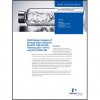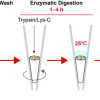
As snow melts it can leave pollution behind in the form of micro- and nano-plastics according to a study from McGill University. The pollution is largely due to the relatively soluble plastics found in antifreeze products (polyethylene glycols) that can become airborne and picked up by the snow.
The researchers have developed a new nanostructured laser desorption/ionisation time-of-flight mass spectrometry (NALDI-TOF-MS) technique to analyse snow samples collected in April 2019 in Montreal for both micro- and nano-sized particles of various plastics. The NALDI-TOF-MS technique is orders of magnitude more sensitive than any of the other current methods used for tracing plastic in the environment. It allows scientists to detect ultra-trace quantities (pg levels) of many of the most common soluble and insoluble plastics in snow, water, rainfall and even in soil samples once they have been separated.
“It is important to be able to detect even trace quantities of plastics in the environment”, says senior author, Parisa Ariya, from McGill’s Departments of Chemistry and Atmospheric and Oceanic Sciences. “Though these plastics may be harmless in themselves, they can pick up toxic organic matter and heavy metals from the environment, which can damage human cells and organs.”
Zi Wang, a PhD Candidate at McGill adds, “Our hope is that this new technique can be used by scientists in different domains gain key information about the quantity of micro- and nano-plastics in urban environments in order to better address their impacts on the ecosystem and on human health.”




![Targeted proton transfer charge reduction (tPTCR) nano-DESI mass spectrometry imaging of liver tissue from orally dosed rat (Animal 3). a) optical image of a blood vessel within liver tissue. b) Composite ion image of charge-reduced haeme-bound α-globin (7+ and 6+ charge states; m/z 2259.9 and m/z 2636.3 respectively, red) and the charged-reduced [FABP+bezafibrate] complex (7+ and 6+ charge states; m/z 2097.5 and m/z 2446.9 respectively, blue). c) Ion image composed from charge-reduced haeme-bound α-globin (7+ and 6+ charge states) showing abundance in blood vessels. d) Ion image composed from charge-reduced [FABP+bezafibrate] complex (7+ and 6+ charge states) showing abundance in bulk tissue and absence in the blood vessel. Reproduced from https://doi.org/10.1002/ange.202202075 under a CC BY licence. Light and mass spectromert imaging of tissue samples](/sites/default/files/styles/thumbnail/public/news/MSI%20drug-protein%20complex-w.jpg?itok=CBNIjyYl)




